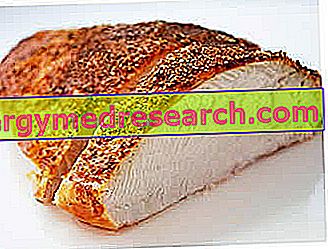Use in the kitchen
The turkey breast is a food of animal origin, very proteic, poor in lipids and without carbohydrates. Thanks to these peculiarities, turkey breast (like chicken breast) is one of the most widely used foods in low-calorie slimming diets, in high-protein diets aimed at bodybuilding and in diets against hypercholesterolemia. More generally, turkey breast is a food that "fits" easily in any diet (with some exceptions such as: serious diseases, such as kidney failure, or specific allergies).

Turkey strips with figs and almonds
X Problems with video playback? Reload from YouTube Go to Video Page Go to Video Recipes Section Watch the video on youtubeCooking
Contrary to what many believe, to prepare a sufficiently soft turkey breast it is NOT necessary to use generous amounts of added fat; in fact, the consistency of cooked meat is compromised above all by its dehydration and protein modification, but not by the escape of lipids; the cooking method that makes the turkey breast more dull is the EXCESSIVE charcoal grilling, since the radiation and convection deprive the food of all its liquid components (read the article: Cooking techniques (or systems) ); frying and grilling, on the other hand, are the most suitable methods for packaging turkey breast. Apart from the wholesomeness of frying, some readers might dispute these choices by pointing out that they are two almost diametrically opposed systems; in reality, frying and cooking on the griddle have the same physical effect on the turkey breast: the formation of the crust (protein) outside the food that prevents the leakage of the liquids contained within it . A very high temperature and extremely short cooking times are therefore necessary for cooking turkey breast; however, we remind our users that, to do all this, it is necessary to cut turkey breast steaks so that their thickness does NOT exceed 1.0-1.5cm.
WARNING! Methods of over-cooking turkey breast can increase the risk of toxic molecules forming; read the articles: protein cooking - fat cooking.
Practical advice to avoid disgrace in the preparation of turkey breast in a natural, grilled, grilled or frying pan: having guests at dinner, it can happen that one of them has special dietary requirements; generally, as a substitute for any dish, the most popular food is turkey breast (or chicken) but, on the other hand, it is also the most complicated food to make palatable through "natural" cooking. As we have seen, the biggest problem is the hard and filamentous consistency that the turkey breast acquires during cooking; nothing easier to remedy. In this case we proceed with the packaging of the well-known paillard, a meat-based dish which, by definition, must be well cooked ( NB . No more than 2-3 minutes are enough) and very thin; the thickness is less than 0.5cm and as such it facilitates chewing by compensating for a more firm consistency. Combining a mayonnaise with yogurt or a green sauce with parsley, you're done.
The most avid consumers of turkey breast could develop, over time, a sort of addiction to taste; I therefore suggest using marinades in wine (of different types) or in citrus juice, and seasoning with various spices (rosemary, thyme, marjoram, citron, thyme, lemonade, savory, sage, mint, lemon balm, bay leaf, black pepper, pepper rose, green pepper, curry pepper, curcuma, cumin, coriander, bay berries, juniper berries, etc.).
Nutritional Properties
The turkey breast is an economical and easy to contextualize ingredient, both for the accompaniment of the first courses, and for the stuffing of the sandwiches; this because, similarly to the chicken breast:
increases the plastic intake and effectively compensates for the protein value of cereals or legumes MA, being lean and WITHOUT skin, does not significantly affect the fat balance and the amount of cholesterol .
| Nutritional composition of turkey, topside, raw (wording food composition tables - INRAN) | ||||||||||||||||||||||||||||||||||||||||||||||||||||||||||||||||||||||||||||||||||||||||||||
 | ||||||||||||||||||||||||||||||||||||||||||||||||||||||||||||||||||||||||||||||||||||||||||||
Nutritional values (per 100 g of edible portion) | ||||||||||||||||||||||||||||||||||||||||||||||||||||||||||||||||||||||||||||||||||||||||||||
NB . Many values have been voluntarily omitted in the absence of sufficiently precise data; however, in the description that follows, these characteristics will still be mentioned by virtue of their nutritional importance.
| ||||||||||||||||||||||||||||||||||||||||||||||||||||||||||||||||||||||||||||||||||||||||||||
The turkey breast brings several vitamins: especially niacin (vit. PP), pyridoxine (vit. B6) and cobalamin (B12); also present are: thiamine (vit. B1), riboflavin (vit. B2) and pantothenic acid (B5).
Good quantities of the mineral salts typical of meat (both white and red), iron (Fe - heme type), phosphorus (P) and zinc (Zn) are appreciated; there are also small doses of selenium (Se).
The total energy intake of turkey breast corresponds to 107kcal / g (source INRAN), divided into: 95% protein and 5% lipids (1/3 saturated and 2/3 unsaturated - about 1/3 monounsaturated and 1 / 3 polyunsaturated). The amino acid called limiting, since it is less present among the essentials, is the tryptophan followed by cystine; as for the others, in decreasing order, the most concentrated are: glutamic acid, aspartic acid, lysine, leucine and arginine. Among the fatty acids, C16: 0 (palmitic), C18: 1 (oleic) and C18: 2 (linoleic acid) stand out above all; the ratio of polyunsaturated and saturated fatty acids is equal to 0.9, while cholesterol plays an almost marginal role with its 50mg / 100g.
Turkey breast: with or without skin?
WARNING! In choosing the turkey breast at the supermarket, it is common to come across cheaper packs still to be cut and WITH LEATHER; in this case, we remind consumers that, in order for the turkey breast (in the dish) to have as little lipids and cholesterol as possible, it should be cooked WITHOUT skin (except in the grill method with embers). This is a decisive factor since it allows the food to be cooked without the fats that are largely contained in the animal's tagging apparatus and which are released from it by cooking; eating a turkey breast "with skin", compared to the analogous "without", causes a significant increase in the intake of triglycerides and cholesterol while eliminating it subsequently to cooking, then directly in the dish (following a preparation in a pan), part of the fat will still remain in the dish.
Role in the diet
Being particularly thin, the turkey breast (like the chicken breast) makes it possible to draw on food sources of the finest fats, maintaining a correct nutritional distribution of the diet; an example of this is RAW extra virgin olive oil, cold-pressed and NOT hydrogenated vegetable oils, but rich in polyunsaturated fatty acids (grapeseed, walnut, kiwi, flax etc.), dried fruit (achenes such as walnuts, almonds, pine nuts) etc.) and, separately, also krill oil supplements.
NB . The turkey breast, in the diet, has an essentially plastic function (since it contains mainly proteins), therefore, being devoid of typical vegetable nutrients (fibers, antioxidants, electrolytes typical of vegetables and other functional molecules) it should be contextualized in the diet in a manner balanced or at least weighted.
Turkey breast: how to choose it
The turkey breast is a fairly inexpensive food although, similarly to other foods, what determines the possible price increase is the quality factor associated with the costs of the production cycle. The most expensive turkey breast is the organic one, while the average is the home-cooked one, which is more tasty, but less expensive. On the other hand, if the difference in the animal's lifestyle has a profound effect on the taste of its flesh, it does not necessarily make it safer! It is common among natural food lovers to try to get supplies from small domestic (not certified) turkey farmers; this habit, which will undoubtedly satisfy the palate of the user, at the same time subjects it to an increased risk of infection due to: food poisoning, parasites, etc. On the other hand, the "recently" turkey breast has questionable organoleptic-gustatory (and chemical) characteristics. Therefore, it is advisable to prefer certified foods that derive from the processing of animals raised on the ground and in an extensive manner. Furthermore, if it does not put too much burden on the family economy, the choice of a guaranteed organic turkey breast could certainly be the right compromise.



